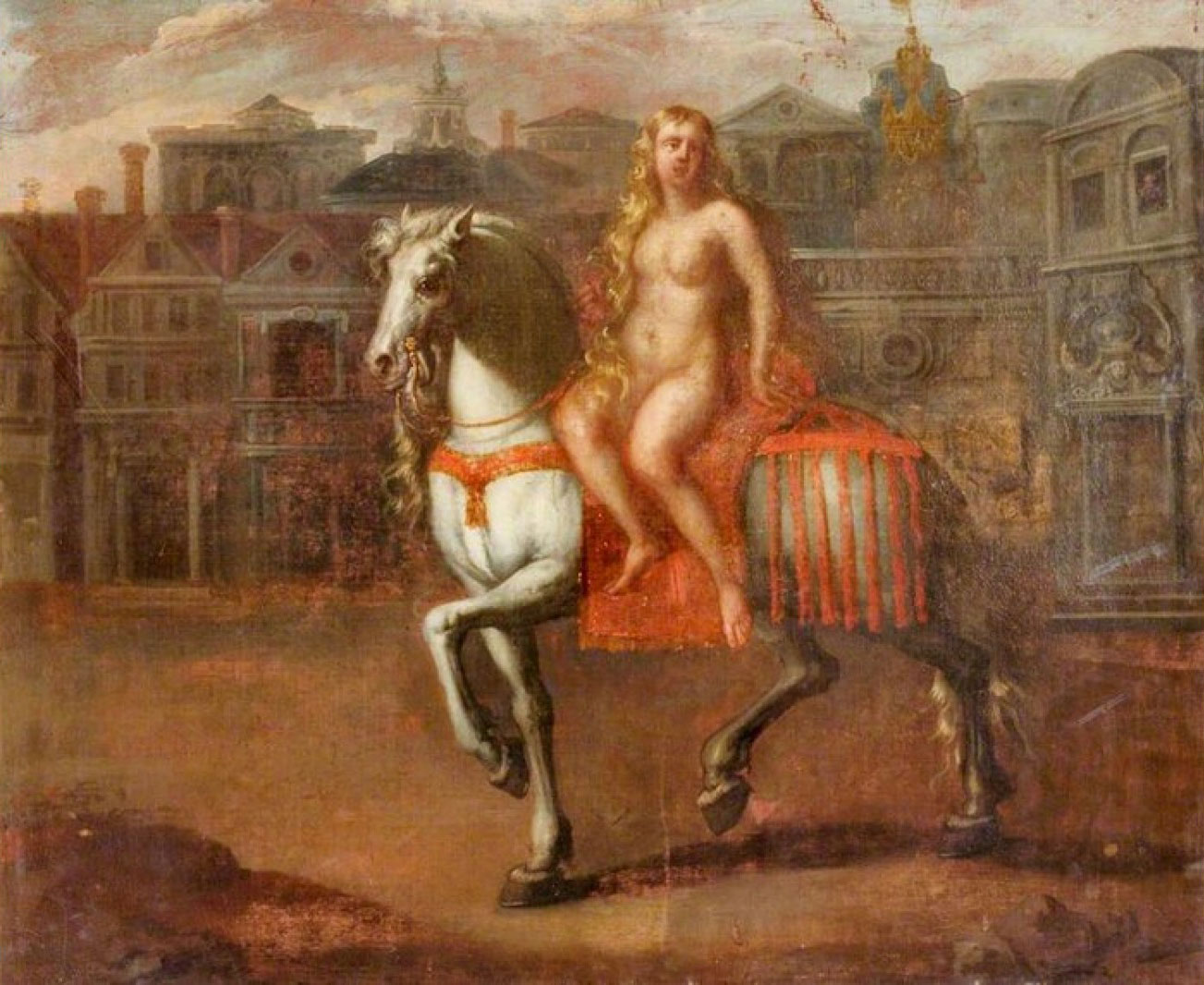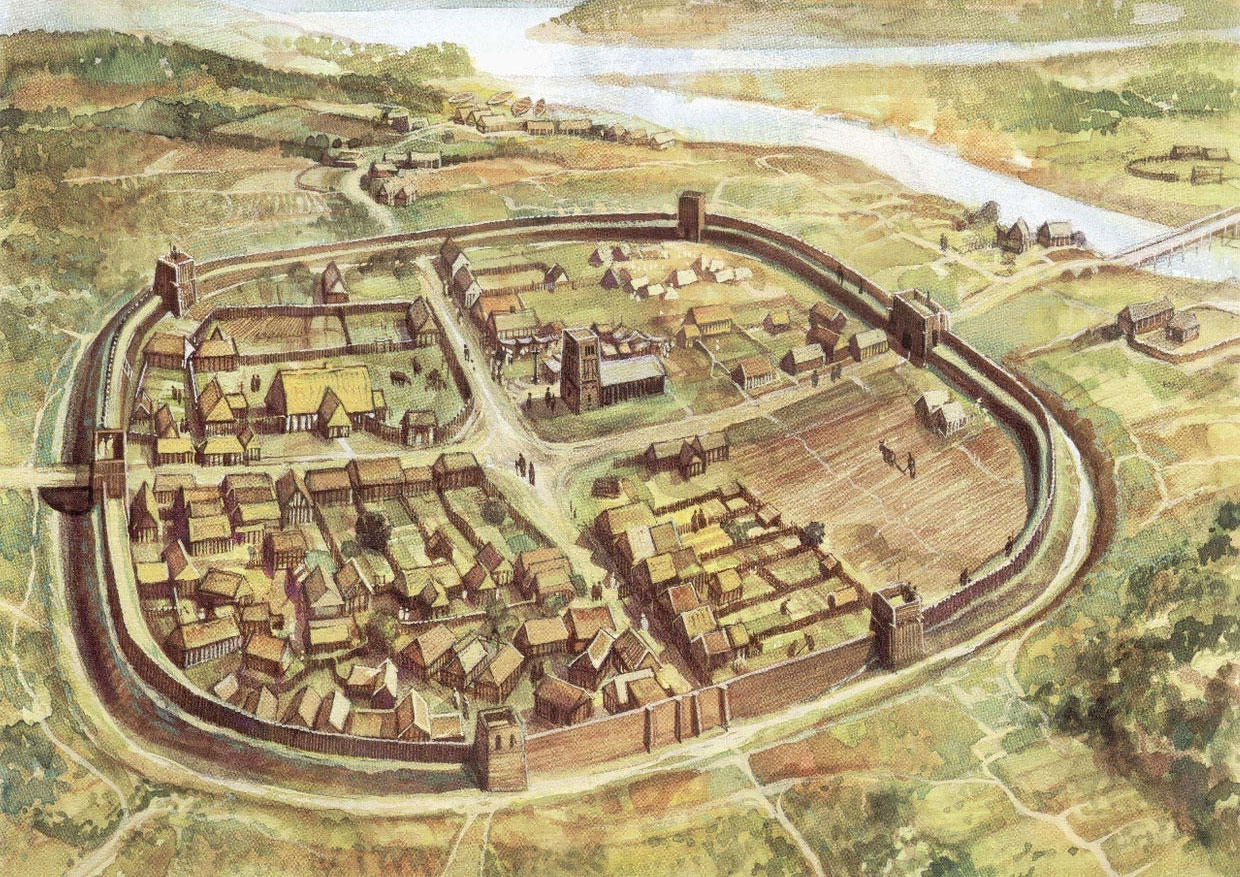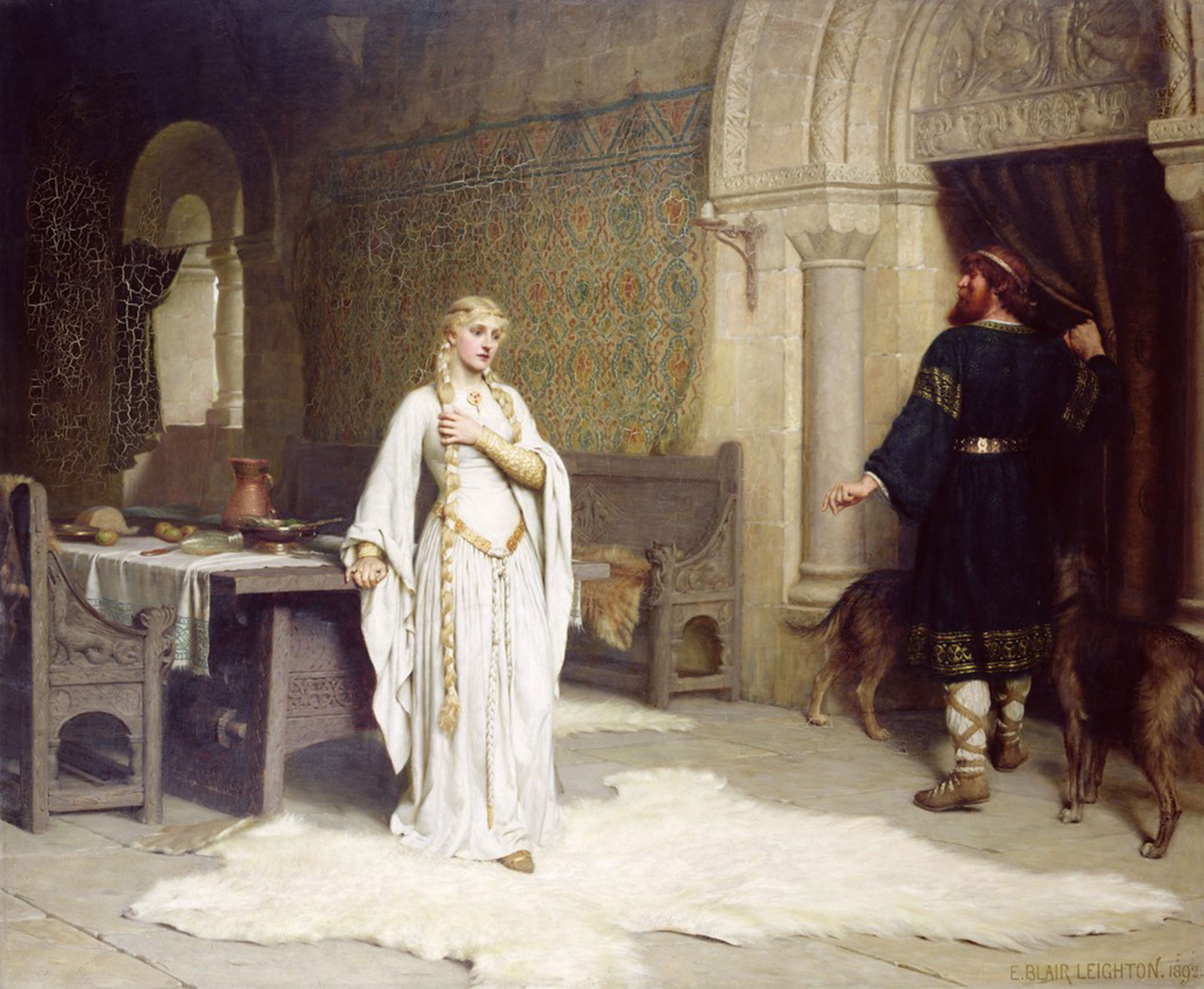


A peep at the naked truth about the legendary lady who bared all for her people



A peep at the naked truth about the legendary lady who bared all for her people

Her legend has inspired countless songs, paintings and statues, a half-dozen movies and innumerable books, including a ribald novel written and illustrated by Theodore Geisel—yes, Doctor Suess. Tennyson immortalized her in verse. Chocolates, nuclear reactors and even an asteroid have been named for her. Feminists, nudists and tax protesters all claim her as their patron saint. She is part of Western popular culture, though few people know anything about Lady Godiva except that she supposedly rode through some town on a horse, naked. But did she?
Woman of Legend Her story was first written down by the monk Roger of Wendover, in his chronicle Flores Historiarum (Flowers of History), sometime prior to the year 1236 AD: The countess Godiva, who was a great lover of God’s mother, longing to free the town of Coventry from the oppression of a heavy toll, often with urgent prayers besought her husband [Earl Leofric of Mercia], that...he would free the town from that service, and from all other heavy burdens; and when the earl sharply rebuked her for foolishly asking what was so much to his damage, and always forbade her ever more to speak to him on the subject; and while she on the other hand, with a woman’s pertinacity, never ceased to exasperate her husband on that matter, he at last made her this answer, “Mount your horse, and ride naked, before all the people, through the market of the town, from one end to the other, and on your return you shall have your request.” ...Whereupon the countess, beloved of God, loosed her hair and let down her tresses, which covered the whole of her body like a veil, and then mounting her horse and attended by two knights, she rode through the market-place, without being seen, except her fair legs; and having completed the journey, she returned with gladness to her astonished husband, and obtained of him what she had asked; for earl Leofric freed the town of Coventry and its inhabitants from the aforesaid service, and confirmed what he had done by a charter. Roger’s account was written nearly two centuries after any such event, as part of his history of the year 1057, when Leofric died. That so notable a story went unmentioned at the time it supposedly happened (perhaps as early as 1045) is the main reason most historians think it never did.
The Real Godiva Godiva, however, was a real person. In the more Germanic English of her day her name was Godgifu or Godgyfu, pronounced goad-yivu and meaning “gift of God.” For Anglo-Saxon women in the years just before the Norman Conquest, it was a common name. The year of her birth is uncertain, given as early as 980 and as late as 1004. Some sources say a first arranged marriage left her widowed around 1028, but able to choose a second husband herself. When first mentioned in the year 1035, she was married to Earl Leofric. 
Lady Godiva by Adam van Noort (1586). Figure in window, upper right, is either Leofric or Peeping Tom. See below. Born in 968, Leofric was named Earl of Mercia (the Saxon equivalent of a count, second only to the king) as early as 1017, certainly by 1024. In his lifetime he served four kings of England—Canute, Harold Harefoot, Harthacanute and Edward the Confessor—and himself became one of the two or three most powerful men in England, “who was very wise before God,” recorded the Anglo-Saxon Chronicle, “and also before the world; and who benefited all this nation.” In 1043, Godiva and Leofric endowed a Benedictine monastery on the ruins of an old nunnery founded around 700AD by St. Osburh, mother of Alfred the Great, but destroyed by Canute’s Vikings in 1016. According to John of Worcester, “He [Leofric] and his wife, the noble Countess Godgifu, a worshipper of God and devout lover of St Mary ever-virgin, built the monastery there from the foundations out of their own patrimony, and endowed it adequately with lands and made it so rich in various ornaments that in no monastery in England might be found the abundance of gold, silver, gems and precious stones that was at that time in its possession.” 
A typical Anglo-Saxon burh, or fortified settlement. Many such towns were founded near rivers for ease of supply. The River Sherbourne has been diverted underneath the modern city of Coventry.
A Matter of Taxes Of course, all that money had to come from somewhere. In the 11th Century, Coventry was no bustling city, but a small village of barely 70 households growing up around the monastery. (The town’s name may be a combination of convent and tre, an old Celtic word for settlement.) Its citizens could hardly have paid enough taxes to finance the richest church in England. We can’t know how Leofric and Godiva managed their finances, but she didn’t have to ask him to abolish taxes on Coventry. She could do it herself. In contrast to later, more patriarchal Norman society, Saxon women could acquire and own property, through inheritance or purchase. Godiva owned Coventry and several other local villages outright. All taxes were paid to her except for the heregeld, a national property tax demanded by pre-Conquest kings to pay their soldiery. It was abolished by King Edward the Confessor in 1051, but until then, as a major landowner, Godiva would have had to beg any remission from the king himself, or perhaps persuade Leofric to intercede on her behalf. An investigation during the reign of Edward I (1272-1307) confirmed that in 1057 no taxes were paid in Coventry except on horses. According to the Polychronicon, written by the monk Ranulf Higden in the first half of the 1300s, Leofric freed Coventry from all taxes, save on horses. In 1569 the town’s Minister to Parliament, Richard Grafton, concurred that Leofric had lifted “any maner of Tolle, Except onely of Horsse.” 
By Victorian times the roles of Godiva as virtuous savior and Leofric as bullying overlord, shown here by Edmund Blair Leighton in 1892, had become tradition. How the Story Changed Yet somehow Leofric, the wise ruler and generous benefactor, is remembered as an oppressive overlord and bullying husband. And if Godiva rode at all, she may have been a matron in her forties, possibly near her eighties. (In 1057 Leofric would have been 89.) Some historians have claimed the fable originated in pre-Saxon, pre-Christian, Druid fertility rituals, in which a virgin May Queen paraded through town as a rite of spring, probably on foot. Others maintain Godiva indeed rode, but in a silk or cotton shift, or stripped only of jewelry and aristocratic finery. Certainly the story changed drastically over the 200 years before Roger dared put it on parchment. He probably heard it from monk John of Wallingford (died 1234), whose history of England from the years 449–1036 was based on information handed down by John of Worcester (died 1140) from Florence of Worcester (died 1118), who would have compiled his work under the direction of Wulfstan, Bishop of Worcester (died 1095). Wulfstan was born around 1008 and almost certainly knew Godiva personally. He was, however, likely no friend of Leofric. In 1041, when Godiva was already his wife and Wulfstan was a monk in Worcester’s Benedictine abbey, two of Harthacanute’s tax collectors were killed by the citizenry, and on the king’s orders Leofric laid waste the city. Furthermore, the earl was later involved in land disputes with the abbey, which the church lost. On top of that, Wulfstan was a confidant of Earl Harold Godwinson of Wessex, Leofric’s main adversary for power under the king. At the heart of the tale, then, may have been an effort to disparage the Earl of Mercia, told in whispers and never written down on pain of punishment, thereby allowing it to change, and yet gain credence, with each retelling. Once somebody used the word nacod, of no uncertain meaning even in those days, things really took off. Godiva Goes Viral In those simpler times, a man’s greatest asset was his bravery. For a woman, particularly a noblewoman, it was her virtue. Only young unmarried girls wore their hair loose and uncovered. To hear of a married woman, especially one of Godiva’s rank, with her hair down in public—let alone covering nakedness—was the feudal equivalent of a private sex video gone viral on the internet. It’s easy to imagine a series of lifelong celibate monks, locked away in their chambers, sweating over such a tale. It would have gathered steam as it went, over the centuries being fashioned bit by bit into an archetypal medieval morality play. Leofric, the wise benefactor of Coventry, was an oppressor of Worcester, and so rewritten as a tyrant imposing a tax on horses, a mainstay of village life. An aged Godiva may have walked a few hundred yards in a re-enactment of a pagan rite, wearing a penitent’s shift and bereft of her noblewoman’s finery; for the purposes of the story she needed to shed a few decades, lose her clothes, and gain a noble steed. Add a skulking villain and you’ve got a bestseller. Peeping Tom He didn’t come into the story until the 17th Century, 600 years after the fact. Though all Coventry’s townspeople were ordered to lock themselves in their homes with the windows shuttered when Godiva rode through (wattle-and-daub Saxon huts had few windows to begin with), a tailor named Thomas supposedly drilled a peephole. Depending on the version of the story, as punishment he was struck blind, or dead. Thomas, however, is a biblical, not Saxon, name. His character was almost certainly inserted into the tale by later Puritan writers, to personify divine retribution for giving in to temptation. Today the phrase “Peeping Tom” has become so well known that few people even associate it with Lady Godiva.
Godiva’s Legacy Leofric died in 1057. His son with Godiva, Aelfgar, succeeded to the earldom but died in 1062. His daughter, Godiva’s granddaughter Edith (Ealdgyth or Aldgyth), known as Ravenhair, was a famous beauty widowed by two kings, Gruffydd ap Llywelyn of Wales and Harold II of England. She is often confused with Harold’s previous hand-fast (common-law) wife, Edith Swanneschals (Swan Neck), another renowned beauty. After Harold died in the Battle of Hastings, Edith Ravenhair vanished from history. Godiva survived the Conquest. Norman accounts name her as one of the few Anglo-Saxons, and even fewer women, to remain a major landholder. Her mother and daughter-in law, Aelfgar’s wife, were both of the Malet family of Normandy; Godiva’s maternal uncle, William Malet, fought for William the Conqueror at Hastings, and may be the reason Godiva was spared. The date of her death is uncertain, possibly as early as 1067—September 10th is mentioned—the year after the Conquest, but the Norman Domesday Book records her as holding many estates in Warwickshire, including Coventry, as late as 1086. She died as one of the four or five richest women in England, with estates valued at £160, but her lands were then forfeit to the Normans. She was most likely buried with Leofric in Coventry, though the exact site has long since been lost. The church they founded, St. Mary’s Priory and Cathedral, stood until the Dissolution of the Monasteries by Henry VIII, in 1539. In 2001 archaeologists excavating the ruins uncovered part of the east window (where, traditionally, the images of benefactors were depicted), including the stained glass image of a beautiful woman with wavy, golden hair. She is thought to be Godiva. Godiva Today The Victorians, needing a release for their pent-up passions, raised Godiva to her current semi-mythical status. Tennyson wrote his poem in 1842. She became a popular subject of paintings and sculptures. Famously prudish Queen Victoria went so far as to give her consort, Prince Albert, a silver statue of Godiva on horseback. Off and on going as far back as 1678, Coventry has held an annual Godiva procession, with leading ladies sometimes played by boys, a wooden effigy of Peeping Tom dating from circa 1500, and predictable hysterics from the moral authorities. Today it’s become a three-day music festival. Around the world, girls still hop astride horses in various states of undress to support causes, protest injustices, or simply be seen. A scantily clad woman on a horse will never fail to be noticed. 1902: actress Vera Guedes (Silent) 1929: Miss Murial Mellerup (Silent) 1951: Actress Anne Wrigg But Lady Godiva, in legend if not fact, was the first. To quote Tennyson, “To meet her lord, she took the tax away / And built herself an everlasting name.” Marry an earl or two, be renowned for your piety and famed for your donations to the church, be grandmother to a queen (twice), and be lost to history. But ride one horse through town naked, and nobody will ever forget you. 
Godiva by John Thomas (1813–1862), Maidstone Museum & Art Gallery, Kent Author/illustrator/historian Don Hollway has been published in Aviation History, Excellence, History Magazine, Military Heritage, Military History, Military Heritage, Civil War Quarterly, Muzzleloader, Porsche Panorama, Renaissance Magazine, Scientific American, Vietnam, Wild West, and World War II magazines. His work is also available in paperback, hardcover and across the internet, a number of which rank extremely high in global search rankings. Comments loading....
|
